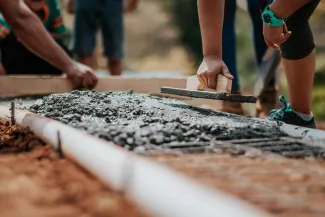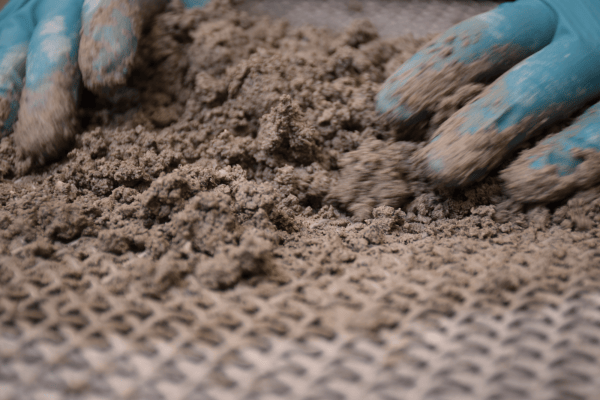
Circular construction
Circular construction or circular building is an important factor in the transition to a circular economy. Together with the construction industry, we are looking for solutions that are focused on recycling and reusing valuable building materials and future-oriented designing and (re)building.
What is circular construction?
In a circular economy, buildings and building materials are used, reused, adapted and rebuilt for as long as possible. That way we avoid too many materials ending up as waste and having to tap ever more new sources of material.
Circular construction is more than the reuse and recycling of building materials (urban mining). Everything starts with the design of a building. Does it guarantee long and sustainable use? Can it easily be adapted to future needs? Does it facilitate the reuse of building materials once the building has been demolished? ...
When looking at new building materials, it is important to use natural and easily recyclable materials. Other raw materials that can become exhausted are used as efficiently and effectively as possible.
Why is circular construction important?
Circular building offers a solution to several problems. It can transform the building industry from having a significant environmental impact into an industry that actively contributes to the sustainable future of Flanders.
The construction industry in Flanders currently produces some 15 million tonnes of waste, which accounts for about 35% of our waste. Construction and demolition activities are responsible for 5 to 12% of our national CO2 emissions.
Circular building can have a major impact on these figures, with a positive effect on the climate, the environment, economic growth and employment. By using fewer materials, reusing materials and closing (local) loops of raw materials and materials, global CO2 emissions are reduced.
Get circular advice
Are you an entrepreneur in the Flemish construction business and do you want to start working on circular construction? Are you looking for support todevelop and roll out a circular business model?
Rely on VITO’s advice to prepare your company, products, strategy and processes for the circular economy. Our experts help you to make the right choice that’s both economically sound and scientifically substantiated.
What are the challenges for circular construction?
There are some bottlenecks or 'systemic barriers' that stand in the way of developing a circular building model:
- Buildings today are mainly designed for a specific purpose.
- Other players, active in the later phases of a building's life cycle, are hardly taken into account.
- The focus today is on building as cheaply as possible.
These bottlenecks were studied in the now concluded European Buildings As Material Banks (BAMB) project. In that project, materials and buildings were designed from the outset to be disassembled and reused later. A building was literally considered a material bank with the zero-waste idea in mind.
Apart from new construction, the question also arises as to what to do with discarded building materials. To what extent can they be reused as urban mines in the circular building economy?
Wim Debacker, Circular Building expert: "A research and experimentation project on demolition has taught us that the greatest challenges are not so much on a technical level, but rather on a systemic one. Think of a lack of trust within the supply chain, the initial cost that is too high, the difficulty of scaling up some solutions and the fact that the potential benefits of circular construction - and also of urban mining - are still little known to clients."
Develop your innovative building material in VITO's Concrete Lab
Do you have an idea for an innovative building material that makes use of alternative (low-carbon) cements and/or secondary, synthetic and artificial aggregates? Then VITO’s Concrete Lab is your go-to place for developing, producing and testing your material. It offers infrastructure to produce and test ready-mixed and prefab (compressed) concrete.
System changes that enable circular construction
Future-oriented design and (re)construction
Buildings and materials must be designed and constructed with a focus on change, in order to maximise reuse. In other words, they must be purposeful and easy to disassemble. To support this, design tools were developed in the BAMB project: Reversible Building Design.
Increasing knowledge and competence in the field
In a circular model cooperation is needed across the entire value chain, including data and information sharing about products, components and buildings. Material passports play an important role here.
Decisions are based on lowest initial cost as well as on long-term effects
We need to evolve towards business models that take into account the costs and benefits across the entire life cycle. These should also be socially and environmentally related. The TOTEM tool, co-developed by VITO, compares the environmental impact of circular and/or linear building solutions.
Creating commitment across the entire value network
We build close partnerships in which each party can create added value. VITO has developed an accessible way to visualise and redesign the advantages and disadvantages of existing and alternative partnerships. Discover it in the guide 'Value Network Mapping'.
Create a targeted support base among decision makers
By highlighting the individual and societal benefits of circular construction, a 'willingness to pay' must be created. We do this by clearly mapping the relative scarcity of raw materials and quantifying the long-term added value of sustainable circular solutions for clients, investors and (end) users.
Support innovation within the construction and demolition industry
By defining a long-term agenda and supporting actions together with (new) small and large companies, governments, investors and civil society organisations, a larger playing field is created from which every active player can benefit. This is currently happening within the Werkagenda Circulair Bouwen.
Contact us
Exchange views with our experts on circular construction. Feel free to contact Michiel.




